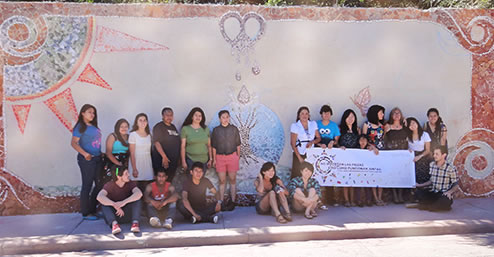Service Snapshots: Mosaics of Peace
Narrative by Carol Pobanz, Project Director
In early January 2014, twenty-four participants from the United States and Honduras joined forces in a project called “It’s Not About the Pieces, But How They Work Together.” The project, a carryover from the Religious Youth Service’s Peace Park activities from the early 2000s, included an art-based service project using mosaic as a catalyst for experiential learning of cooperation and peace.
Some might ask, with all the problems found in developing nations, why would you choose to make a mosaic? Although we did repairs and constructed a security wall on two of the schools in the city during our short stay, the mosaic we created on the main boulevard in the historic city of Comayagua became the zenith of our service experience.
Having academic degrees in both art and religious education, I have always desired to develop activities combining the two fields of interest. I concur with True Father’s words: “People often think that politics moves the world, but that is not the case. It is culture and the arts that move the world. It is emotion, not reason that strikes people in the innermost part of their hearts. When hearts change and are able to receive new things, ideologies and social regimes change as a result.”
In August 2000, True Father introduced the idea of Peace Zones in a speech called “Renewing the United Nations to Build Lasting Peace.” He said: “These Peace Zones would be havens that exist for the sake of peace, prosperity and reconciliation. They would be free of racial and sexual discrimination, human rights violations and war. These areas would also be ecological and environmental havens for the entire natural world.” He suggested that they be created between, and on the borders of, all nations.
When I heard this speech I was working at the Universal Peace Federation (UPF) in the already successful projects of the Religious Youth Service (RYS). These service projects were basically carried out, according to the vision of True Father, by young people from various faith traditions, working cooperatively to serve humanity. I began to think how difficult it might be to create an entire zone of peace but that, maybe, as an initial step, a peace park could be constructed. I began asking the questions, “How can art be a service to humanity? How can art be used for the sake of peace?” And I began to see the arts—visual arts, cooking arts, music, dance and sports—as languages that transcend national and even religious spheres.
The Mosaics
During my time in RYS, I was able to organize mosaic art projects in the United Kingdom, the Netherlands, New Jersey and then last year, with Generation Peace Academy (GPA), in Honduras (my family’s mission nation), and then this recent project. In each case, the design for the project was made cooperatively by a group of young people (and, in some cases, a composite design was made incorporating the work of young children). For example, the recent mosaic done in Honduras was designed by two young North Americans and two Hondurans. Thus, the final piece was a reflection of the unity of these two nations.
The mosaic created in Honduras depicts a troubled world, symbolized by a tree in arid soil, trapped in a bubble, and surrounded by a radiant ideal world of peace. Breaking the bubble was a drop melted from a composite symbol of peace and true love nourishing the arid world, and consequently bringing it new life.
Before one can really understand this project, one needs to understand mosaics as an art form. Mosaics are made up of many small pieces of tile, glass, stone and beans or just about anything arranged harmoniously in a scheme. In order to create the mosaic, three major things are needed: the design, the pieces you are using to realize the design and the grout or cement that holds the whole thing together.
The mosaic is a strong metaphor for cooperation and harmony. As with all art forms, the “creator” gleans lessons through the experience; lessons about creatorship, ownership, balance, harmony, dissonance, positive and negative use of tension, reconciliation, beauty, expression, communication and love. One learns through the mosaic that no one piece is more important than another, that every piece maintains its own integrity while at the same time maintaining a responsibility to preserve the harmony of the whole.
The Human Mosaic
While we were creating this mosaic on a wall in the city with tiles and glass, there was another mosaic being created consisting of the many people who helped make this project happen. The designers of the mosaic were Mario Salinas, the director of Family Federation for World Peace and Unification (FFWPU) and the Universal Peace Federation (UPF) Honduras and I. A total of 24 participants in the project also comprised the human mosaic, which included the eight young adults and two Women’s Federation for World Peace (WFWP) members from the United States and from Honduras; one Ambassador for Peace and five young guests (three of whom were adult children of Ambassadors for Peace); three of FFWPU Honduras’ young adults; and three WFWP women. Other pieces of the mosaic were the New Jersey church members who donated to the efforts of the fundraising participants before the event and the 100-plus people in the community whom we stopped on the street and invited to place a piece of tile into our mosaic design. The ladies who cooked for us and their families who surrounded us with love, all the home-stay families who cared for us, the city workers from the municipality who supported our activities, the dancers who entertained us, and the people from the city who will see or have heard our message, “It’s Not About the Pieces, But How They Work Together”—these were all pieces of the human mosaic. The grout—that which held us together—was our friendships and the relationships of love we developed with all of these people.
The Pieces
This project, though initiated by myself, was also designed, in part, by the participants. After sharing the vision of the project, Miwa Ishikawa and Yoshimi Suzuki designed this year’s T-shirt with the words “It’s not about the pieces, but how they work together” which became the theme of the project. Throughout our time in Honduras, we came to appreciate the strengths of each participant. Although we were unable to speak a common language, each found a way to relate and found his or her place in the larger design. Participants took responsibility for morning inspiration, monitoring group movement, project management and fulfillment, cleanup, and bookkeeping and financial accountability. Everyone was an Ambassador for Peace in a special way. Photo records and a video were produced by the participants as well.
All the participants voiced an interest in returning to Honduras and/or bringing Hondurans to America to share their culture with us, to bring friends and to further develop the project. My hope is to allow the project to develop organically, relative to the participants in both countries—i.e., the talents they bring, the needs they express, and the inspiration and calling that God whispers in the ear of each individual.
As for me, the most important thing I have been able to contribute to the project was to initiate it. It seems to me that for the amount of inspiration God gives to me (or, to us), there is an equal amount of discouraging self-talk that tries to persuade us to give up on our ideas. Breaking through the discouragement and initiating the project was my greatest battle, and the victory became the seed for something that is developing a life of its own.
I cling to the idea of developing actual parks in nations and on borders, as the seeds to the Peace Zones spoken about by True Father.
As Abraham Lincoln said, “Do I not destroy my enemies when I make them my friends?” Through cultural and art exchange we have the possibility to develop appreciation and friendships with our worldwide family, thus working proactively to create peace.
Contributed by Carol Pobanz
If anyone is interested in participating in this project, or developing a project of their own, please contact carolpobanz@gmail.com.

